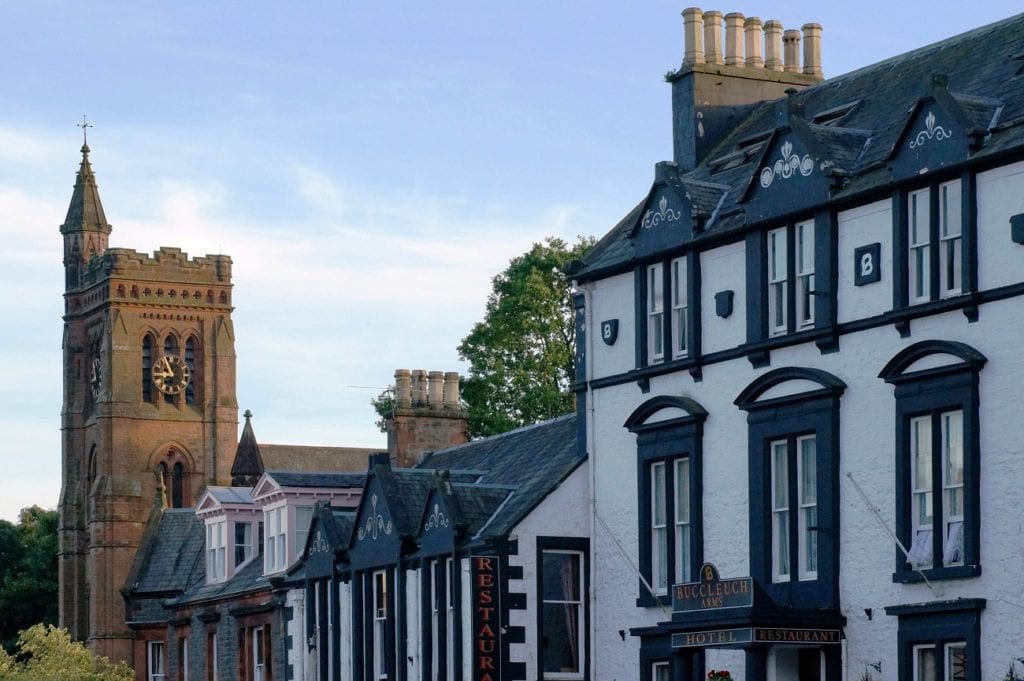A former royal burgh and Victorian spa town, Moffat quickly charms most visitors with its mix of quirky shops and cafés, village atmosphere, range of architecture and new distillery.
Located amid some of the Southern Uplands’ grandest scenery, it’s only around an hour’s drive from both Edinburgh and Glasgow, thus it works well for both short breaks and as a base for a longer holiday. Walkers and cyclists are in their element as nature abounds, and there are good birdlife and wildlife spotting opportunities in the area.
Moffat is also the UK’s first Dark Sky Town, having adapted its street lighting to reduce light pollution, and the Moffat Astronomy Club, with their new observatory and 16-inch Meade telescope at Hammerlands, would be pleased to hear from visitors. There are also three fixed telescope piers around the town.
Visitors are also welcomed by the Friends of Gallow Hill to assist in their mammoth tree-planting task on the northern edge of town. Since being acquired from the Earl of Annandale in a community buyout in late 2016, the hill has been planted with over 17,000 trees, with another 20,000 to go. This is also one of the nearest and easiest hills to town for walking.
A tour of the town
The pleasantly browsable High Street lends itself to a gentle amble up one side and down the other, but do watch out when crossing over as it’s easy to forget that traffic runs in both directions on both sides of the road. At the top of the High Street a statue of a Blackface ram stands atop its cairn of piled-up stones, erected partly to honour Moffat’s historic sheep market but also, say some, in memory of Sir Walter Scott’s contemporary, poet James Hogg, ‘the Ettrick Shepherd’, who was known to drink in the town.

Fondly referred to as the Moffat Ram, it’s known more formally as the Colvin Fountain, having been presented by businessman William Colvin in 1875. Noted for its peculiar lack of ears, it was sculpted by one William Brodie, who is perhaps better known for the diminutive Greyfriars Bobby in Edinburgh.
For a local delicacy, pop into the Moffat Toffee Shop on the High Street. Well Street has a range of more specialised shops including Wallace Brothers butcher on the corner (excellent steak pies and haggis), the independent Moffat Books, Harvest Time traditional delicatessen, the Ram Shack record shop (as in vinyl), and three vintage/antique furniture and bric-a-brac shops: Lothlorien Antiques, Reloved and 27 Well St.
Towards the bottom of town is the community-run Moffat Museum, with informative displays that include a Roman brooch found in the nearby hills in 1787 and the oldest longbow discovered in Britain. Merlin, with whom Moffat and the surrounding area have strong associations, is also covered. Moffat itself lies on the Merlin Trail, the website of which also includes details of the Moffat History Trail.
Opposite the museum stands the late 19th-century St Andrew’s Church (down the side of which Santa abseils each Christmas for the annual lights switch-on), while just around the corner, at the bottom of the high street, is the old Holm Street churchyard, with the last remaining wall of the pre-Reformation church (c1600). What is obvious when walking around the site is the varying heights of the ground. In 1747, the churchyard was covered in an extra 4ft of soil to create more space for burials.
The Moffat Hills
The scenery around Moffat is among the most thrilling in the region. Here, too, is a good selection of birdlife: peregrine, merlin and golden plover may be spotted, to name a few, and possibly even golden eagle.
This area was historically of great strategic importance, for whoever controlled Upper Annandale controlled access to the north and south; today it is dotted with sites of Roman forts and the remains of medieval castles.
Our suggestion is to focus on the north and east of the region to immerse you in the surrounding countryside, areas that sit just inside the boundaries of Dumfries and Galloway and which also stray into the neighbouring Scottish Borders region. Unfortunately, public transport isn’t an option for these routes, so driving is your best bet, or cycling if you’re a very fit, regular cyclist.